Military Team Tragedies
While more than 400 ballplayers have lost their lives in military service not all have been isolated incidents. On a number of occasions, a military baseball team, often in transit from one place to another, has suffered fatalities. Here are the stories of six such events:
Tragedy of
the USS Maine
In Florida, in December 1897, the baseball team of
the battleship USS Maine defeated a team from the cruiser USS
Marblehead, 18-3, to earn the title Navy baseball champions. Led by
engine stoker and pitcher
William Lambert of Hampton, Virginia, the only black player
on the team who was described as “a master of speed, curves, and
control,” the team’s next game was scheduled with an all-star squad in
Havana, Cuba.
On February 15, 1898, Marine Corps Fifer
C.H.
Newton, the ship’s bugler and the ball team’s third
baseman, blew taps as the Maine bobbed listlessly in Havana Harbor.
Shortly afterwards, the Maine blew up, killing 261 of the crew and all
but the baseball team’s right fielder, John Bloomer. In addition to
Newton, the bugler, the ballplayers killed that evening were Ordinary
Seaman
William H. Gorman (second base) of Boston, Landsman
Charles Hauck (centerfield) of Brooklyn, Landsman
William L. Hough (first base) of New York, pitcher
William Lambert, Apprentice First Class
Benjamin L. Marsden (catcher) of Jersey City, New Jersey,
Landsman
John Merz (shortstop) of Brooklyn, and Landsman
William H. Tinsman (leftfield) of East Deering, Maine. Also
killed were the team’s manager Gunner’s Mate First Class
Charles F. W. Eiermann of New York, and Seaman
Leon
Bonner of New York, the manager’s assistant. In addition,
to lose his life aboard the Maine that night although not a member of
the ship’s team was Yeoman Third Class
John H. Shillington of Chicago, who had played shortstop
with Notre Dame.
Two months after the loss of the USS Maine, April 25, 1898 saw the start of the Spanish-American War, during which the rallying cry, “Remember the Maine! To Hell with Spain!” was frequently heard.
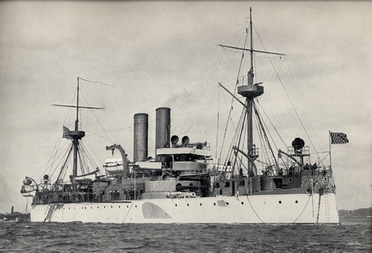 |
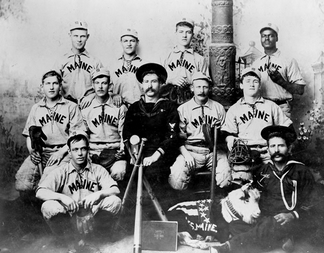 |
Plane Crash at Victorville, California - 1943
On Sunday, May 23, 1943, the Victorville Army Air Base Bombers were
scheduled to play a game in Las Vegas, and a number of the players were
going to fly there. The short flight was to end in tragedy.
The official story released by the military claimed a Beechcraft AT-11 Kansan was struck by another AT-11 while on a bombardier training exercise. One plane crashed at Silver Lake, California, about 90 miles from Victorville, killing all on board, while the other plane, which suffered minimal damage, managed to land safely back at the airfield. In truth, the two planes were heading to Las Vegas for the ball game and the pilots were playing games with each other when one plane cut the tail off the other. On board the crippled AT-11 were 2/Lt. Harold B. “Hal” Dobson, a former minor league pitcher, Sgt. John A. Lowry, a semi-pro ballplayer from Arnold, Pennsylvania, and Sgt. William E. Thomas, a semi-pro player from Pittsburgh. They were all killed along with the pilot, 2/Lt. William S. Barnes.
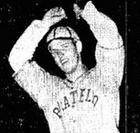 Hal Dobson |
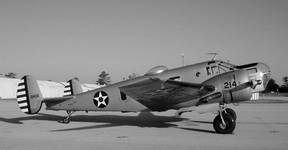 |
Lightning Kills 6 Soldiers Playing Softball at
Fort Belvoir, Virginia -1943
On Tuesday August 10, 1943, a softball game
had just concluded at Fort Belvoir when a storm struck. Nine of the
players sheltered under a large tree which was promptly struck by
lightning. Fort ambulances and medical department trucks rushed to the
scene but were unable to revive six of the men who had been struck by
the lightning. Three survived with burns.
The six men killed were:
Pfc. Julian D. “Bud” Rosin of Chicago, IL (aged 26)
Pvt. Philip W. Hiance of Cold Springs, KY (aged 30)
Pvt. Russell R. Heller of Philadelphia, PA (aged 22)
Pvt. James A. Hood, Jr., of Augusta, GA (aged 30)
Pvt. Chester E. Dearing of Richmond, VA (aged 29)
Pvt. Cornelius J. “Jack” Caverly of Muskegon, MI (aged 20)
All were members of Company C, 355th Engineer
General Service Regiment.
Rosin had only been at Fort Belvoir for two days and his engagement to
Elaine Abrams had been announced at the start of the month. Heller was
married to Catherine and they had a 1-year-old daughter, also named
Catherine. Dearing was married to Annie and they had three daughers.
Plane Crash at Foster Field,
Texas
On August 9, 1945 – the Foster Field Falcons traveled to Childress Army Air Base in Texas, for a ballgame. The Falcons won the contest and five of the players – Cpl. Peter J. Zarrilla, Sgt. H. Duard Lawson (an amateur first baseman from Princeton, Texas), 1/Lt. Harold G. Phillips (a semi-pro catcher from Georgia), S/Sgt. Chester V. Seipp (a semi-pro shortstop from Pasadena, Maryland) and Cpl. Lester O. Clotiaux (a Refinery League catcher from Nederland, Texas), along with 2/Lt. Peter R. Davis (a veteran transport pilot with 1,500 hours to his credit) flew back to Foster Field in a twin-engine Beechcraft AT-7C airplane. On the return journey the plane crashed and burst into flames near Smiley, 60 miles east of San Antonio, Texas. All six men were killed.
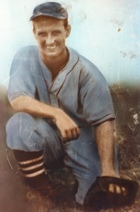 Les Clotiaux |
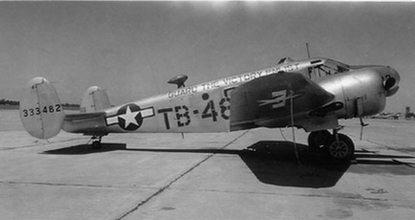 |
Army Truck Hits Train in L
Following the German surrender in May 1945,
military baseball teams travelled across Europe entertaining troops. It
was while traveling with the 84th Infantry Division team was travelling
through Hesperange, Luxembourg that
tragedy struck. The ball team was riding in the back of an Army truck
when it struck a train on October 22, 1945. Among the injured was former minor league
outfielder Sgt.
Eugene L. Dellinger. Dellinger was badly burned and
evacuated to Northington General Hospital in Tuscaloosa, Alabama before succumbing to his
injuries on January 31, 1946.
Identified as being on the truck:
Sgt.
Eugene L. Dellinger of Bahama, NC (Died from injuries)
Pfc. Anthony F. Kunigelis of Plymouth, PA (Killed)
Pfc. Charles E. Taylor of Kansas (Killed)
Pfc. William E. Weisenmiller of Cumberland, MD (Killed)
Negro 440th Port Company Team Plane Crash at Iwo Jima - 1946
During the afternoon of November 16, 1946, the 440th Port Company baseball team were flying back to Iwo Jima after having taken part in a tournament on Guam. Aboard the Curtis C-46F Commando (44-78961) transport plane, piloted by Captain James C. Queen, were four other crew members, four US Army personnel and the 15 African-American members of the baseball team. Heavy cloud cover made the approach to Iwo Jima difficult and as the twin-engined plane approached Airfield No. 3 it was too high and missed the runway. The plane was still descending, however, and hit the water just off the island. It rapidly sank and all on board lost their lives.
The 440th Port Company baseball team:
Sgt. Joseph Bowers (Camden, SC)
T/4 Fred Brown (Ama, LA)
T/5 Robert L. Goins (Loganport, IN)
S/Sgt. Vivien L. Harris (Newark, NJ)
T/5 Emanuel M. Jackson (Occoquan, VA) - 3527th Transportation Corps
T/5 Jessie L. Glover (East St. Louis, IL)
T/5 Carnell Boyd (Hickory Valley, TN)
Pfc John T. Eatmon (Brooklyn, NY)
Pfc Jonathan Culbertson (Baltimore, MD)
Pfc Clarence W. Brown (New York, NY)
Sgt. Earnest Flowers (Chicago, IL)
Cpl. Harry L. Edmonds (Canton, MS) - 3527th Transportation Corps
Pfc L.C. Hollins (Ore City, TX) - 536th Quartermaster Company
Pfc William Jenkins, Jr. (South Charleston, OH) - 536th Quartermaster
Company
Pfc Robert Hillman, Jr. (Thomaston, GA)
Crew members: Cptn. James C. Queen, 1/Lt. George Eisenhaur, 1/Lt. Richard G. Davis, Sgt. Earl C. Glass and Sgt. Stanley Brudney
Passengers: Pfc George A. Knoll, 2/Lt. Dwight K. Gilbert, WOJG Alfred J. Di Pietro and Pfc Arthur Brown
.jpg)
San Antonio Plane Crash - 1947
On the night of April 9, 1947, a U.S. Army Douglas
C-47D Skytrain (43-49258), took-off from Kelly Field in San Antonio,
Texas, enroute to Davis Monthan Field at Tucson, Arizona. Onboard were
three crew members and sixteen African-American military baseball players headed to a tournament.
Immediately after take-off the plane was in trouble. It cleared some
homes adjacent to the airfield then crashed in a cotton field and burst
into flames. Many of the players were injured and taken to the hospital
at Kelly Field. There were two fatalities - Sgt. Marvin L. Tapp - who
was a crew member and died in the crash, and Captain Walter A. Meadows,
who died in hospital on April 13.
Crew:
Cptn. Walter A. Meadows (pilot) - died April 13
Lt. Simeon L. Rawls (co-pilot)
Sgt Marvin L. Tapp - died in crash
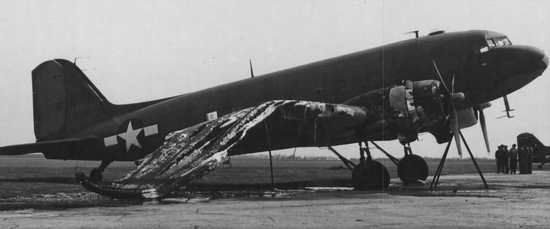
This is the actual C-47 (43-49258) after suffering wing damage in Europe in 1945.
Dutch
Harbor Tragedy
In August 1947, the Dutch Harbor Army-Navy all-star softball team (made up of seven Navy players from the Dutch Harbor Naval Operating Base, Alaska, and six Army players from nearby Fort Mears), were playing in an Alaska-wide tournament held at Kodiak on Kodiak Island. Team players included Y2C William R. Loftus (an amateur outfielder from Omaha, Nebraska), T/5 Delmar E. Nowak of Alpena, Michigan, T/5 Angus MacKay of Detroit, Seaman First Class Cecil H. Suitt of Lake Village, Arkansas and M/Sgt. Jacob R. Swander (a 12-year Army-man from East Altoona, Pennsylvania). Swander's 3-year-old son had been scheduled to make the trip with his father because the team's catcher had a broken thumb and couldn't play, leaving a spare seat. At the last minute, the catcher decided to go and Swander's son lost his seat on the plane to Kodiak Island.
After the tournament finished, the 13-man team left
Kodiak on August 6, at 0626 hours to make the 600-mile journey to Dutch
Harbor aboard a U.S. Navy Consolidated PBY-5A Catalina (V34032) flying boat. The
PBY had a crew of five (including John Duval, Seaman First Class Pervis
L. Bangert and Bryce S. Herndon) plus two other Navy passengers
(including Lt. Cmdr. Willard A. Ethridge) as well as the
team. Pilot-in-command Lt. (jg) William H. Zeigler and co-pilot Lt. (jg) Nave A. Fuliehan,
made their last report at 1045 hours about 150 miles from Dutch Harbor.
After that, the PBY was never seen or heard from again.
A major search was conducted in the hope that the
plane might have made a safe landing in sheltered waters along the
route, with its radio damaged. Joining the search were transient
aircraft and military planes from Fort Randall, Fort Richardson, Kodiak
and Adak. The Navy cargo ship USS Sussex, enroute to Adak, was sent to
the area to direct the surface operations, in which Coast Guard vessels
and the Navy fleet tug USS Potawatomi participated.
All searches failed to locate anything that might indicate what happened to the PBY. A year later, with still no trace of the plane or passengers, all 20 passengers were declared dead. Ironically, many of the Navy personnel were due to have been discharged from service three weeks after the tournament. Some years later, wreckage that washed ashore at St. George Island, Alaska, is believed to have come from this plane.
Players identified as being on the plane:
Y2C William R. Loftus, Omaha, Nebraska
T/5 Delmar E. Nowak, Alpena, Michigan
T/5 Angus MacKay, Detroit, Michigan
Seaman First Class Cecil H. Suitt, Lake Village, Arkansas
M/Sgt. Jacob R. Swander, East Altoona, Pennsylvania
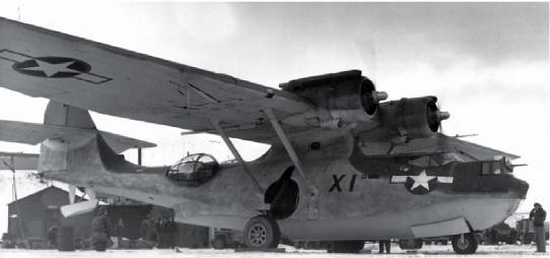 |
A Consolidated PBY-5A Catalina at Kodiak Naval Air Station
13th Air Force Plane Crash - 1947
On September 20, 1947, the 13th Air Force baseball team was returning to Clark Field at Luzon in the Philippines, after playing games in Tokyo and Okinawa. The Curtiss C-46D Commando (44-78263) twin-engined transport plane, which was piloted by Edwin B. Cearley, ran into bad weather over northern Luzon on the five hour flight. Off course and running low on fuel having been in the air for eight hours and 15 minutes, Cearley gave the order to abandon the airplane using parachutes. Of the 27 personnel aboard, 25 landed safely, one was killed as he left the plane and one, Corporal Vernon Meadows, was unaccounted for. Thirty-seven USAF planes were involved in the search to recover the men. The abandoned C-46 had come to rest in a cane field near Tandul in the Cagayun Valley about 160 miles northeast of Manila. It was relatively undamaged. Cpl. Meadows was found alive and well in Bontoc, a mountain province of north Luzon, on September 23.
Onboard were:
Maj. James T. Gribble of Sylva, NC
Maj. W. F. Bound
Cptn. Edwin. B. Cearley (pilot) of Selmar, TN
1/Lt. W. Weiz(x)el
1/Lt. J. F. Mika
1/Lt. J. A. Nations of Atlanta, GA
Sgt. J. W. Buckingham
Sgt. C. J. Butkovich
Sgt. A. E. Blair
Sgt. A. W. Alford
Sgt. J. C. Polk
Sgt. A. O. Peterson
Sgt. O. B. Johnston
Sgt. E. E. Davis
Sgt. T. J. Katzben
Cpl. U. B. Moore
Cpl. F. Patricio
Cpl. M. R. McCorckle
Cpl. A. E. Westgaard
Cpl. J. M. Carhart
Cpl. A. J. Baker
Cpl. Vernon I. Meadows (missing for a day after parachuting)
Pvt. S. W. Reese
Pvt. J. W. Dickason
Pvt. R. Murphy
Baseball Team Parachute to Safety in North
Africa – 1953
At 7:15pm on August 8, 1953, a USAF C-119 Flying Boxcar carrying six
crew and 18 passengers, left Udine, Italy, bound for Wheelus Air Base in
Libya, North Africa. Among the passengers were members of a United
States Air Force baseball team.
At around 10:00pm, the plane suffered an electrical failure that knocked
out the radio and lights. The last contact made with the plane was over
the island of Ponza in the Tyrrhenian Sea.
Original reports claimed the plane had crashed into the sea, north of
Sicily and that U.S, British and Italian planes, as well the British
frigate HMS Roebuck were involved in rescue attempts.
In reality, the plane had reached the mainland of North Africa, but when
an engine cut-out, co-pilot Captain James E. Sholty of Windfall,
Indiana, ordered all 18 passengers and three crew members to put on
their parachutes and exit the plane. All 21 were quickly found in the
desert, with only one requiring medical treatment.
The remaining three crew members, including Sholty, exited the plane
shortly afterwards and walked for several hours before being found by
Arabs, who gave them water. They were taken to a Libyan police post and
from there, driven to Wheelus Air Base. The wreckage of the C-119 was
found 60 miles south of Tripoli.
Personal account of Airman Second Class Thomas P. Pouk, Jr., of Streator, IL
“I am glad that I am writing this letter. I had an
experience that I would never forget as long as I live. I suppose you
heard of a plane missing over here. It isn’t any more because they found
us.
“I never thought I could jump out of a plane but when I knew it was my
life I did. And I mean to tell you I was afraid and prayed.
“We had a wonderful time in Trieste, Italy, but coming back our electric
system (which also disabled the radio) failed and we were lost over the
Mediterranean Sea.
“So we headed south to hit land. We only had so much gas and when one
engine went out, they gave us orders to bail out.
“We did and Mom, the good Lord gave us all 10 ball players nerve to
jump. We were all out in 30 seconds. I didn’t know if we were over land
or sea and thank Lord that we were over land.
“Twenty-four of us (the team members and crew) jumped and 24 came back.
One man had a sprained foot. We were very lucky because we landed in
nothing but rock.
“I was the real lucky one. I couldn’t get my chute open. I fell for a
long way and finally I got it open after I hit another fellow 30 feet
from me.
“Inside of 30 minutes (after the jump) eight of us were together. We
jumped at 3 o-clock in the morning. We slept until daylight and then the
eight of us started north for the seas. We carried one boy for about
five miles.
“Then we ran across 11 other fellows by the plane. That made 19 of us.
This was Sunday morning. That afternoon some of the fellows found
several kits and they got a few things. We still didn’t have water or
food so a kid named Tony and I started out looking for food and water.
“We walked a long way. Finally I found it (evidently supplies from the
crashed plane) and I prayed that night. An Arab boy found us and went
and got the police. They brought us water and then Monday they came and
got us out.
“If they didn’t find us, we would have died because they were out at
seas looking for us.”
Personal account of Airman Second Class
Monan A. Lovell of Oak City, UT
“I guess you read about a C-119 going down some place in the
Mediterranean or whereabouts therein. Well I was in the plane and had to
bail out of it. Was quite an experience, but I never want to go through
it again, believe me. I will just give you a little account of it now,
cause I am tired and can’t write too good yet.
“We left here [Wheelus Air Base] at 7:40 Friday morning and had a
wonderful trip up to Trieste. Was really beautiful. We played ball, and
had two games for Sunday when Wheelus sent word up fot the plane to come
back, that it was needed and to bring the baseball team.
“Well, that really made us mad. But we had to do it. So we played ball,
got beat 7-4 and got on the plane.
“We all went to sleep, cause it goes faster and is a lot better. We just
got out of Naples aways when our radio and everything went dead. We had
no electric power at all. The pilot was flying blind.
“Our Flight Engineer came back and woke us up and said, ‘Say, get on
your parachutes, we may have to bail out.’
“I thought he was kidding….but he came over to me and said it was a
fact, and asked me to help calm the guys and help him fix the emergency
survival set-up. So I helped him fix them up, helped the guys put on the
cutes and life rafts and Mae Wests. Boy, I really worked for a couple of
hours.
“There were 24 of us and not one had ever bailed out of an airplane
before, and brother, I was one scared baby.
“We flew around trying to find an airport or something. We didn’t know
whether we were over land or water. So that was the chance we were
taking. From then on we just sat around and had to sweat it out until
our gas ran out.
“Then at 2:40 the left engine ran out of gas, and he feathered it and
said, ‘Let’s go, men – JUMP.’
“So at 2:45 we started to jump and it took 18 of us less than a minute
to get out so it was nice that none of us froze at the door. We just
started to lawk and just gave a dive out the door into thin air and pray
that the parachute opened up.
“Boy was it hell when that wind hit us and spun us through space. We hit
165 miles an hour slip stream. Then after turning over about nine times
and dropping 200 or 300 feet, I pulled the rip-cord and that was it. It
opened and gave me a jar and it was the most wonderful feeling I ever
had to look up and see that big orange and white chute above me.
“It took about 15 minutes to get to the ground, and we were over the
ground in some little mountain hills. Rocks, my land, and boy they were
hard. We had jumped out at 9,000 feet, so we were a long way up. When I
hit the ground I thought I was going through a cloud, and BANG, I hit,
all on my left leg and then on the right side of my face.
“We hit the ground going about 40 miles an hour. But it didn’t hurt me
any just a few cuts on my face and leg, that’s all.
“Boy, was I scared but I just rolled over and prayed like never before.
Then I got up and found a couple of other guys and went for the others.
We slept in our chutes and the next day hunted for food and water and
didn’t find either one. We went over 20 hours without water out there.
Another 10 hours and we never would have made it, cause of the heat.
“Then an Arab came along and we got him to bring us water, and he told
the police and then sent water to us and contacted Wheelus, so Monday
they came and got us. I have been over to the hospital in Wheelus most
of the time.”
Bryan Air
Force Base Bus Crash
On August 26, 1955, the Bryan Air Force Base
baseball team was traveling by bus to a tournament at Barksdale Air
Force Base in Shreveport, Louisiana. On the Bryan team was S/Sgt.
Frederick A. LeClaire, who had pitched for the Goldsboro Cardinals in
1950. About three miles from Cushing, Texas, the bus blew a tire and
plunged over a 30-foot embankment into a dry creek.
The injured managed to crawl out the windows or were helped out by rescuers. Trapped in the wreckage and fatally injured were A/1c Lloyd D. Buresh, a young ballplayer from Karlin, Missouri, and the driver of the bus, A/1c James C. Kirkpatrick of Buff City, Tennessee. Both died at a Nacogdoches hospital shortly afterwards.
Fred LeClaire was among the 13 others who were
injured, four of them critically. However, there were no further
fatalities.
Players involved in the bus crash were:
A/1c Lloyd D. Buresh of Michigan
M/Sgt. William C. Littlejohn, Jr.
A/1c George E. Smith
S/Sgt. Frederick A. LeClaire (pitched for the Goldsboro Cardinals in
1950)
T/Sgt. Robert T. Moore (team manager)
A/2c Eugene C. Chigounis of Passaic, NJ
A/2c Robert C. Zittlow of Wisconsin
A/2c Lewis Robinson of Medford, MA
A/1c Lionel J. Noreau, Jr. of Massachussetts
1/Lt. Pasquale P. Pavone of Massachussetts (in charge of the team)
A/2c Bobby E. Jackson of Austin, TX
A/2c John H. Shaver of Wyoming, PA
A/2c Edward E. Heymen of Miami, FL
A/lc James Creager
On July 29, 1963, five servicemen - members of the Fort Polk (Louisiana)
baseball team – were returning to base in a government station wagon
after a 3-game series at Fort Sill, Oklahoma (Fort Pol won the first
game, 2-1 in 10 innings and the second game, 8-0, before dropping the
third game, 4-3). On the Stemmons Expressway, west of the Dallas Drive
intersection in South Denton, Texas, the vehicle was hit by a gust of
wind, apparently a whirlwind, and thrown out of control. It struck a
curb and rolled over twice.
Tony Lawrence, Marion Hughes and Sergeant David K. Leonard (the driver
of the car and former minor league pitcher in the Cardinals
organization), suffered minor injuries. Al Roan and Ron McHugh, were
both seriously injured and flown to Brooks General Hospital in San
Antonio. William “Billy” McKeever, 21 of Pittsfield. MA, was thrown from
the vehicle and pronounced dead on arrival at Flow Memorial Hospital in
Denton. McKeever had been a star basketball player at North Adams State
College in 1960/1961 and was due to be released from military service in
30 days. He had enrolled at the college again for the coming year.
Tony Lawrence RF (minor injuries)
Marion Hughes 1B (minor injuries)
David K. Leonard P (minor injuries)
Al Roan (serious injuries)
Ron McHugh SS (serious injuries)
William “Billy” McKeever LF (killed)
| Can you add more military team tragedies and help make this the best online resourse for military baseball? Contact us by email |
Baseball's Greatest Sacrifice is associated with Baseball Almanac
Baseball's Greatest Sacrifice is proud to be sponsored by
